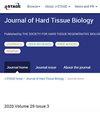TPC1和TPC2促进破骨细胞生成
IF 0.4
4区 医学
Q4 ENGINEERING, BIOMEDICAL
引用次数: 0
摘要
破骨细胞分化是调节骨量的关键步骤之一,涉及rankl诱导的细胞内ca2 +水平的变化。之前,我们报道了溶酶体ca2 +通道,双孔通道(TPC)亚型2 (TPC2)在破骨细胞发生过程中的功能,使用TPC2敲除RAW264.7细胞系(RAW)。然而,由于在RAW中脂质转染效率相对较低,因此尚未研究过表达TPC2的影响。在本研究中,使用改进的脂质转染方法将TPC2转染到RAW和RAW衍生的成熟破骨细胞样细胞中。TPC2主要位于破骨细胞的褶边样结构中。此外,过表达TPC2促进破骨细胞分化。此外,检测TPC1的表达水平,并将TPC1表达载体转染RAW,研究TPC1在破骨细胞发生中的作用。tpc1转染的RAW细胞可促进破骨细胞分化。值得注意的是,TPC2表达不受TPC1过表达的影响。此外,TPC1被siRNA敲低,导致TRAP活性降低。TRAP是破骨细胞发生的生化指标。我们的研究结果表明,TPC1和TPC2在破骨细胞的分化中具有独立的重要作用。本文章由计算机程序翻译,如有差异,请以英文原文为准。
TPC1 and TPC2 Promote Osteoclastogenesis
: Osteoclast differentiation is one of the key steps that regulate bone mass and involves RANKL-induced changes in the intracellular Ca 2+ levels. Previously, we reported the function of a lysosomal Ca 2+ channel, two-pore channel (TPC) subtype 2 (TPC2), using TPC2-knockout RAW264.7 cell line (RAW) during osteoclastogenesis. However, the effects of overexpressed TPC2 have not been examined because of the relatively low lipid-based efficiency transfection in RAW. In this study, TPC2 was transfected in RAW and RAW-derived mature osteoclast-like cells using an improved lipid-based transfection method. TPC2 was predominantly localized in the ruffled border-like structure of the osteoclasts. Moreover, overexpression of TPC2 promoted osteoclast differentiation. In addition, expression levels of TPC1 were measured, and TPC1-expressing vectors were transfected into RAW to investigate the role of TPC1 in osteoclastogenesis. Osteoclast dif ferentiation was promoted in TPC1-transfected RAW. Notably, TPC2 expression was not influenced by TPC1 overexpres sion. Furthermore, TPC1 was knocked down by siRNA, resulting in reduced TRAP activity. TRAP is a biochemical indica tor of osteoclastogenesis. Our findings suggest that TPC1 and TPC2 have independent essential roles in the differentiation of osteoclasts.
求助全文
通过发布文献求助,成功后即可免费获取论文全文。
去求助
来源期刊

Journal of Hard Tissue Biology
ENGINEERING, BIOMEDICAL-
CiteScore
0.90
自引率
0.00%
发文量
28
审稿时长
6-12 weeks
期刊介绍:
Information not localized
 求助内容:
求助内容: 应助结果提醒方式:
应助结果提醒方式:


